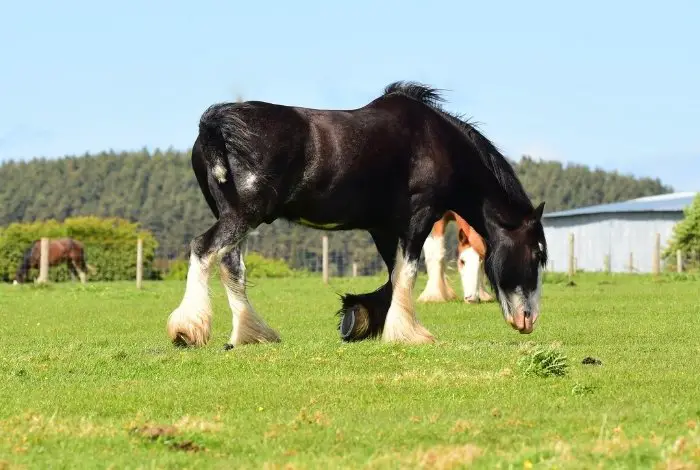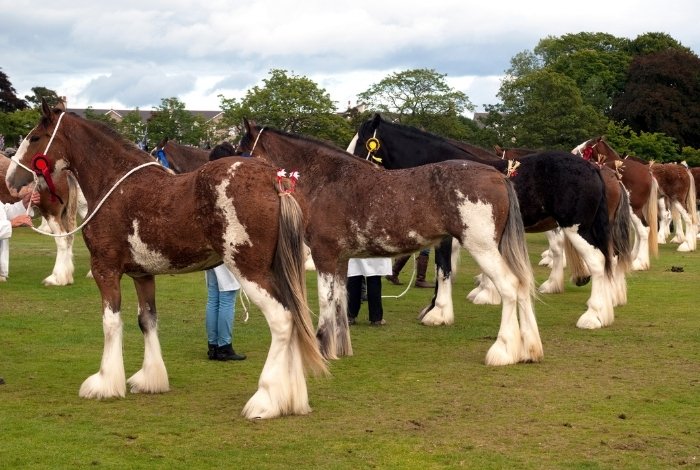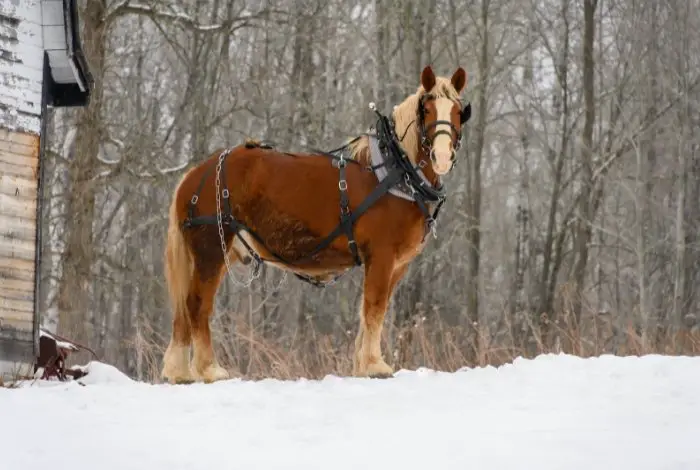Last Updated on February 24, 2023
Horses come in all shapes and sizes, from miniature to enormous, so here, we will look at how the Clydesdale horse compared to a normal horse. The term normal is relative, every horse is normal. But in some ways, the Clydesdale is very different from a regular horse.
What Is A Clydesdale?
Before we dive into the differences between a Clydesdale and a normal horse, let’s take a look at the breed. A Clydesdale is a draft horse breed. Draft horses developed before their sportier cousins that we see today.
Draft horses started out as war horses. Their size, strength, and calm temperament suited long rides and chaotic environments. When the need for a lighter calvary horse came into fashion, the draft horse found itself working on farms.
The Clydesdale originated in Scotland in the 18th century. Native horses did not have the size and strength required, so draft breeds were imported from the continent and crossed with natives. After strategic breeding came the Clydesdale horse which is one of the biggest horse breeds in the world.
Clydesdale Size Comparison
The Clydesdale is a large horse that, on average, stands 17 to 18 hands tall. This is much larger than a normal horse, which we will cover shortly. Their average weight is an incredible 2,000 pounds.
The majority of Clydesdales are bay with white leg and face markings. All Clydesdales have feathers on their legs. The breed is incredibly strong, with heavy muscling, and compact bodies.
While once very popular, the Clydesdale and other draft breeds declined in population after the industrial revolution. Due to this, the breed is at risk. The breed is protected and promoted by various societies.

Of all the draft breeds, the Clydesdale is the most recognizable. It is famous for pulling the Budweiser beer wagon, which is seen at events all around the United States. While not so much the Clydesdale, the draft horse heavily influences today’s modern sport horse.
It is the draft horse that breeders refined into lighter, more athletic animals suitable for sporting activities. Even though it is possible to ride a Clydesdale, they best suit work pulling carts, wagons, and plows.
Clydesdale Size vs Regular Horse
What is a normal horse? This is a broad term since even within a normal horse, characteristics can vary greatly. However, some characteristics stay the same across the board.
The average horse stands between 15 and 17 hands tall, with most in the 16 to 16.2 hand ranges. Anything 14.2 and below is a pony. Clydesdale next to regular horse – the average horse weighs 900 to 1,200 pounds, half the weight of a Clydesdale.

Most normal horses are a type of warm blood or hot blood. A draft horse, like the Clydesdale, is cold blood. In the strict sense, blood type simply refers to the temperament and energy of the horse.
A normal horse is not only shorter than a Clydesdale, it is also lighter with finer bone and proportions. Normal horses have a sportier physique, with quicker reflexes. They also can move at faster speeds.
Normal horses do not possess as much raw power as a Clydesdale. Even though many normal horses can capably pull a carriage, they do not have the power or stamina to work long hours pulling heavy loads.
Leg Feathers
The draft horse, like the Clydesdale, has to feather on its legs. This is the long, thick hair you see on the lower leg. A normal horse does sometimes grow longer hair on its lower leg, but it is minuscule compared to the Clydesdale.
My Name is Ramsey: I’m a Clydesdale Stallion
Temperament
The Clydesdale has a temperament in line with all draft breeds. This is a calm and gentle nature that is not easily upset. A normal horse, especially hot blood, is more energetic and sometimes even fiery.
Despite its intimidating size, the Clydesdale is a good horse for timid handlers, since it is less likely to overreact to stimuli. This is much different to hot blood horses, like the Thoroughbred and Arabian, who have lots of energy and spirit.
Interesting Clydesdale Facts
- One of the tallest modern Clydesdales is Remington. Remington stood at an impressive 20 hands. Several decades earlier, another Clydesdale, at the start of the 20th century, King LeGear, was 20.5 hands tall. He weighed in at 2,950 pounds.
- Another modern Clydesdale, Poe, stands at 20.2 hands tall and weighs 3,000 pounds.
- All draft breeds have leg feathering, but Clydesdale has the most.
- Today, the Clydesdale population is around 5,000.

Conclusion
A normal horse and Clydesdale both require that same care all horses need. A Clydesdale horse, compared to a normal horse will need larger stables, higher calorie intake, and specific shoe designs. The Clydesdale is much larger and calmer than a normal horse in most cases.
So, while the Clydesdale is different from a normal horse in many ways, it is still just a horse.
Which is bigger a Belgian or a Clydesdale?
Overall, Belgians are slightly shorter and stockier than Clydesdales with strong shoulders, broad backs, and kind, gentle dispositions. Belgians are in average 16.2 to 18 hands tall. Clydesdales average around 18 hands and can appear a little less muscular and stocky than Belgians. Clydesdales also have a more refined appearance and are better for horse shows.
The Belgians are strong, powerful, and versatile horses. They’re bred to do everything from ranch work to showing. They have a long, muscular body with a wide back. The Belgians usually have an arched neck and well-developed hindquarters. Their legs are short and strong, and their hooves are solid and strong.
Which is bigger a Clydesdale or a Shire horse?
Both Shires and Clydesdales are extremely similar in both, their physical appearance and their character. They do share the same structure, however, Shires tend to be slightly larger and Clydesdales a bit more compact.
How do you tell the difference between a Clydesdale and a Shire?
Shire horses are known for their great strength and size. These sturdy beasts have been used for generations to pull heavy wagons and carts. Their long necks and well-muscled bodies make them hardy and easy to work with. They have a short back and deep shoulder. Their heads are normally long and lean, with a slightly sloped forehead and small ears.
Clydesdales are similarly well-built, but they are stockier, and have more muscular, arched necks and deep chest. Same as Shires, they have short back and strong, powerfull legs with large, round hooves.
Is a Clydesdale a good first horse?
Clydesdales are usually considered the quiet, patient and forgiving type of horse which makes them a good horse for a beginner. Many beginners fall in love with Clydesdales because of their gentleness and their willingness to please. They are steady and patient but also very intelligent and easy to train. Some people think that they are too easy to ride and some people are afraid of them because of their size and weight. It’s true that they are larger than many of the other breeds and because of that the saddle fit can be a bit more difficult for them. However, once you figure that out, nothing can stop you enjoying your ride.
Can Clydesdale horses be ridden?
Despite their immense size and power, Clydesdales make excellent riding horses. They are easygoing, have a relaxed temperament, and are eager to work.
The Clydesdale horse is an ancient breed of horse that has been around for centuries. Originally bred in Scotland, they were used as war horses to pull heavy artillery and carts in battle. Today, Clydesdales are primarily used for pulling purposes, but they do have a reputation for being great fun to ride. Clydesdales are known for their ability to pull weight, and they are also good-natured, soft-tempered animals. Clydesdales are also excellent trail horses because they are very strong, agile, and sure-footed. Breeders of Clydesdales have done a good job over the years of preserving the unique characteristics of this breed.
Michael Dehaan is a passionate horse owner, horse rider, and lover of all things equine. He has been around horses since he was a child, and has grown to become an expert in the field. He has owned and ridden a variety of horses of different breeds, and has trained many to compete in shows and competitions. He is an experienced horseman, having worked with and competed many horses, including his own. He is an active member of the equestrian community, participating in events and teaching riding lessons.

